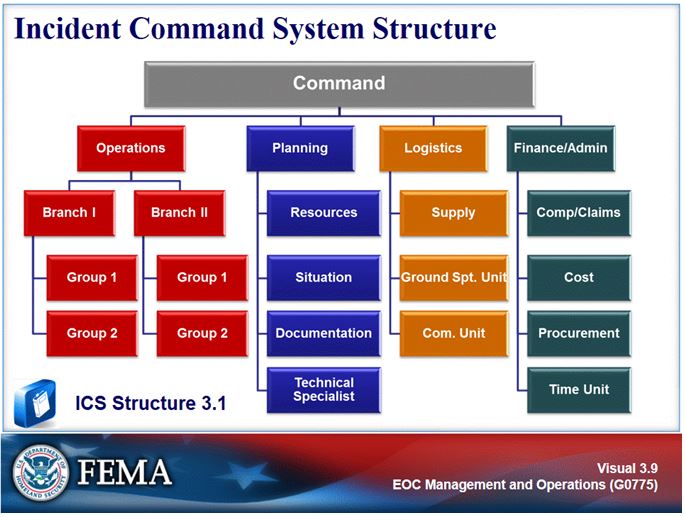National EOC's
National Operations Center
Emergency Operation Centers
National EOC Directory
FEMA.gov
EOC Guidance and Tools
The EOC’s Role in Community
Preparedness, Response & Recovery
What is the EOC?
- An emergency operations center (EOC) is a physical location designed to support emergency response, business continuity and crisis communications activities.
- Staff meets at the EOC to manage preparations for an impending event or manage the response to an ongoing incident.
- By gathering the decision makers together and supplying them with the most current information, better decisions can be made.
What is the purpose of an EOC? - The Emergency Operations Center (EOC) serves a critical role in every phase of emergency management, from being the hub for all coordination during an incident to facilitating and directing recovery/clean-up. However, the EOC does not manage an incident — it coordinates.
- An EOC is used to support on-scene activities through the prioritization of activities and the allocation of available resources. A major function within the EOC is communications between the emergency response team, business continuity team, crisis communications team and company management.
EOC Staff - Pre-designated personnel who understand their roles and responsibilities should staff the EOC. Identified representatives from local response agencies, contractors, volunteer agencies, and any other group with significant response roles may also be asked to support the emergency response from the EOC
|
State Emergency Operations Center Activation Levels The State Emergency Operations Center, located in Tallahassee, serves as the central clearinghouse for disaster-related information, and requests for deployment of assistance. Level 1 - Full Scale Activation of State Emergency Response Team
Level 2 - Partial Activation of State Emergency Response Team
Level 3 - Monitoring Activation
|


What is the EOC?
- An emergency operations center (EOC) is a physical location designed to support emergency response, business continuity and crisis communications activities.
- Staff meets at the EOC to manage preparations for an impending event or manage the response to an ongoing incident.
- By gathering the decision makers together and supplying them with the most current information, better decisions can be made.
What is the purpose of an EOC? - The Emergency Operations Center (EOC) serves a critical role in every phase of emergency management, from being the hub for all coordination during an incident to facilitating and directing recovery/clean-up. However, the EOC does not manage an incident — it coordinates.
- An EOC is used to support on-scene activities through the prioritization of activities and the allocation of available resources. A major function within the EOC is communications between the emergency response team, business continuity team, crisis communications team and company management.
EOC Staff - Pre-designated personnel who understand their roles and responsibilities should staff the EOC. Identified representatives from local response agencies, contractors, volunteer agencies, and any other group with significant response roles may also be asked to support the emergency response from the EOC
ICS Overview
- ICS consists of a standard management hierarchy and procedures for managing temporary incident(s) of any size. ICS procedures should be pre-established and sanctioned by participating authorities, and personnel should be well-trained prior to an incident.
- ICS includes procedures to select and form temporary management hierarchies to control funds, personnel, facilities, equipment, and communications. Personnel are assigned according to established standards and procedures previously sanctioned by participating authorities. ICS is a system designed to be used or applied from the time an incident occurs until the requirement for management and operations no longer exist.
- ICS is interdisciplinary and organizationally flexible to meet the following management challenges:
- Meets the needs of a jurisdiction to cope with incidents of any kind or complexity (i.e. it expands or contracts as needed).
- Allows personnel from a wide variety of agencies to meld rapidly into a common management structure with common terminology.
- Provide logistical and administrative support to operational staff.
- Be cost effective by avoiding duplication of efforts, and continuing overhead.
- Provide a unified, centrally authorized emergency organization.









